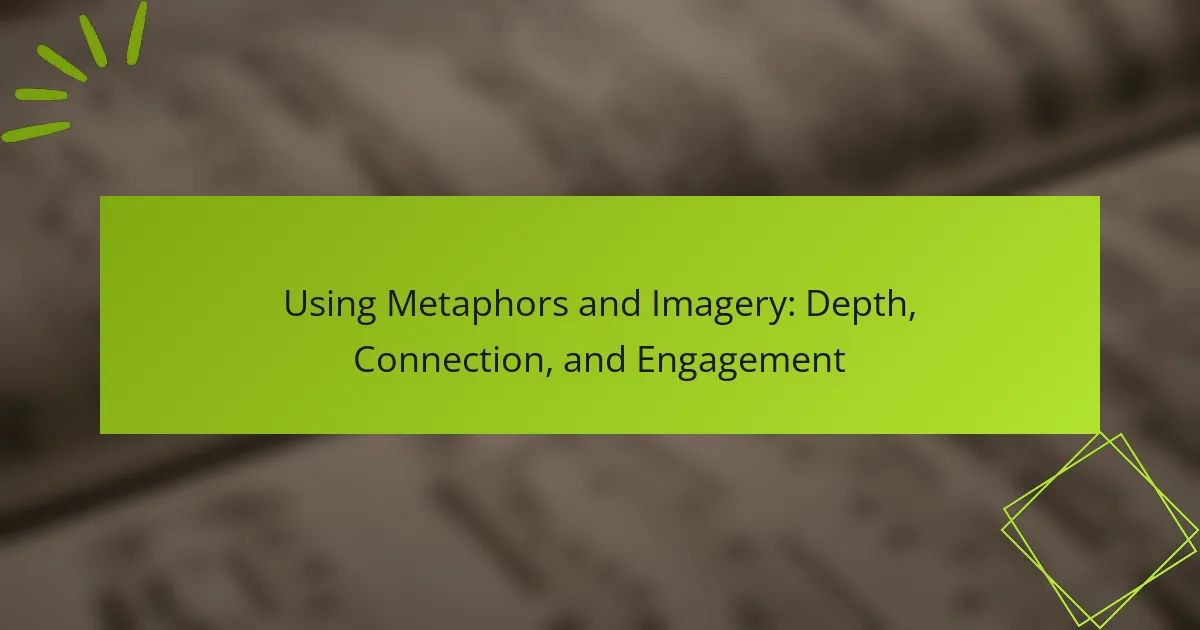Metaphors and imagery play a crucial role in enhancing engagement and connection in writing. By creating vivid mental pictures and relatable comparisons, they make complex ideas more accessible and emotionally resonant for readers. This depth not only fosters understanding but also encourages a more immersive experience with the material.
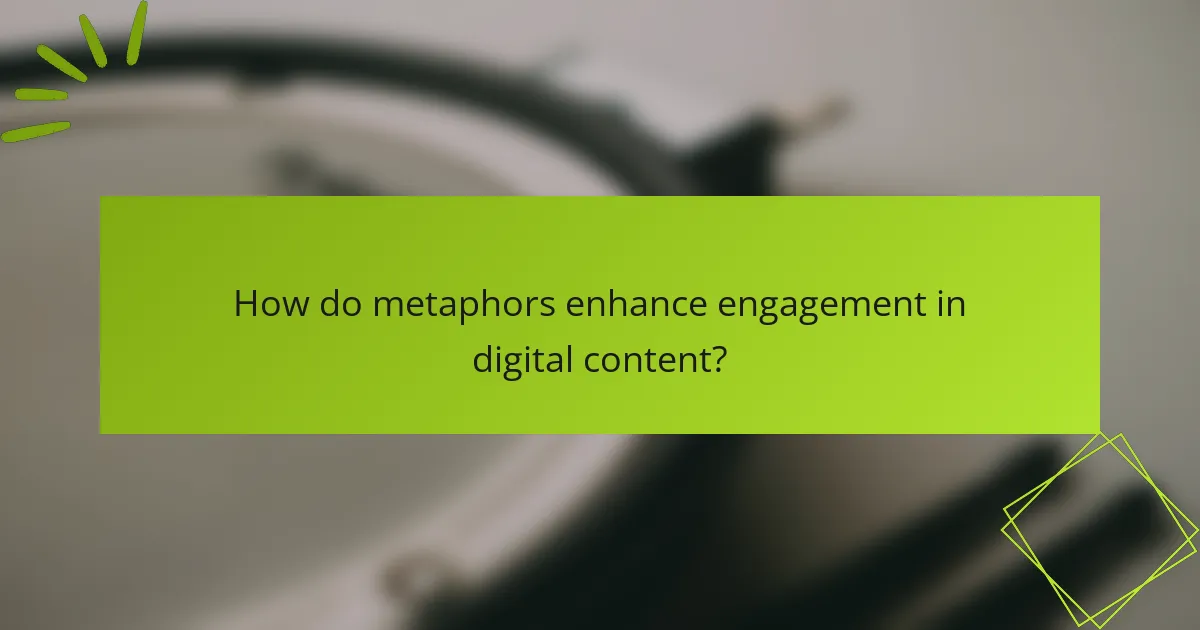
How do metaphors enhance engagement in digital content?
Metaphors enhance engagement in digital content by creating vivid imagery that resonates with readers, making complex ideas more relatable. They foster a deeper understanding and emotional connection, encouraging users to engage more fully with the material.
Increased emotional connection
Metaphors evoke emotions by linking abstract concepts to familiar experiences. For instance, describing a challenging project as “climbing a mountain” can instill a sense of struggle and achievement, allowing readers to connect personally with the content.
To maximize emotional impact, choose metaphors that align with your audience’s experiences and cultural context. This ensures that the imagery resonates and fosters a stronger bond between the content and the reader.
Improved comprehension
Using metaphors simplifies complex ideas, making them easier to grasp. For example, explaining a technical process as “navigating a maze” can help readers visualize the steps involved, enhancing their understanding.
When crafting metaphors, ensure they are clear and relevant to the topic. Avoid overly complicated or obscure comparisons, as they can confuse rather than clarify. Aim for metaphors that are straightforward and directly related to the content.
Memorable messaging
Metaphors create memorable messaging by embedding vivid imagery in the reader’s mind. A striking metaphor can make a message stick, increasing the likelihood that readers will recall it later.
To enhance memorability, use metaphors that are unique yet relatable. Consider testing different metaphors with a small audience to see which ones resonate best. This can help refine your messaging for maximum impact.

What types of imagery are most effective?
Effective imagery enhances writing by creating vivid mental pictures that engage readers. The most impactful types include visual, auditory, and kinesthetic imagery, each serving to evoke specific sensory experiences.
Visual imagery
Visual imagery involves descriptions that appeal to the sense of sight, helping readers to visualize scenes, characters, or objects. This type of imagery can include colors, shapes, and spatial relationships. For instance, instead of saying “the garden was beautiful,” you might describe “the vibrant red roses swaying gently in the golden sunlight.”
To maximize the effectiveness of visual imagery, use specific details and strong adjectives. Avoid vague terms; instead of “nice,” opt for “breathtaking” or “stunning.” This specificity helps create a clearer picture in the reader’s mind.
Auditory imagery
Auditory imagery engages the sense of hearing, allowing readers to “hear” sounds through words. This can include descriptions of music, voices, or environmental sounds. For example, instead of stating “it was noisy,” you could describe “the cacophony of honking horns and distant sirens filled the air.”
When using auditory imagery, consider the emotional impact of sounds. Certain sounds can evoke feelings of calmness or chaos. Use onomatopoeia, such as “buzz” or “whisper,” to create a more immersive experience.
Kinesthetic imagery
Kinesthetic imagery relates to movement and physical sensations, allowing readers to feel the actions described. This can include the sensation of touch, the feeling of motion, or the experience of physical exertion. For instance, instead of saying “he ran fast,” you might say “he sprinted down the track, his heart pounding and legs burning.”
To effectively employ kinesthetic imagery, focus on the physical sensations associated with actions. Use verbs that convey movement and energy, and describe the feelings that accompany those movements to create a more dynamic narrative.
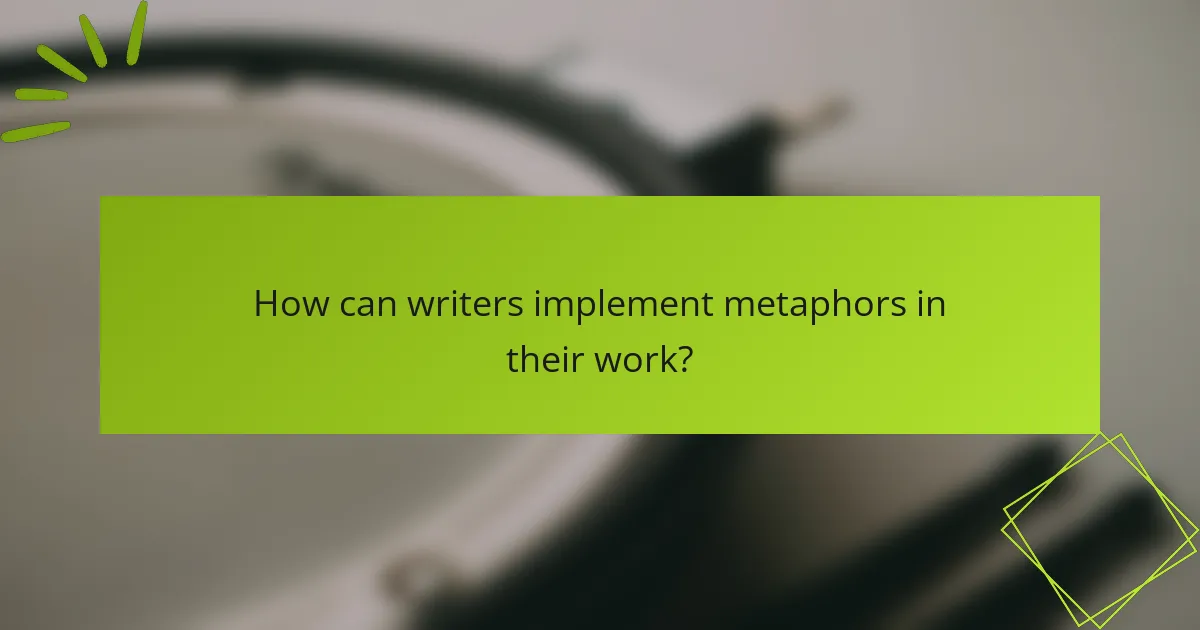
How can writers implement metaphors in their work?
Writers can effectively implement metaphors by weaving them into their narratives to create deeper connections with readers. By using vivid imagery and relatable comparisons, metaphors enhance engagement and evoke emotions, making the writing more impactful.
Identify core themes
Start by pinpointing the central themes of your work. Understanding the main ideas allows you to select metaphors that resonate with those themes, reinforcing the message you want to convey. For instance, if exploring the theme of resilience, you might use metaphors related to nature, like a tree bending but not breaking in a storm.
Consider the emotional undertones of your themes. A metaphor should not only reflect the theme but also evoke the desired emotional response from the reader. This alignment strengthens the overall narrative and makes it more memorable.
Use relatable comparisons
Relatable comparisons help readers connect with your metaphors on a personal level. Use everyday experiences or common knowledge to craft metaphors that are easily understood. For example, comparing a challenging situation to climbing a mountain can illustrate struggle and perseverance effectively.
Avoid overly complex or obscure references that may alienate your audience. The goal is to create a bridge between your ideas and the reader’s experiences, making your writing accessible and engaging.
Incorporate sensory details
Enhancing metaphors with sensory details enriches the imagery and makes it more vivid. Engage the senses by describing sights, sounds, smells, tastes, or textures that relate to your metaphor. For instance, saying “the city buzzed like a hive” not only conveys activity but also invokes the sound and energy of urban life.
Be mindful of balance; while sensory details are essential, too much can overwhelm the reader. Aim for clarity and impact by choosing a few strong sensory elements that complement your metaphor without cluttering the narrative.
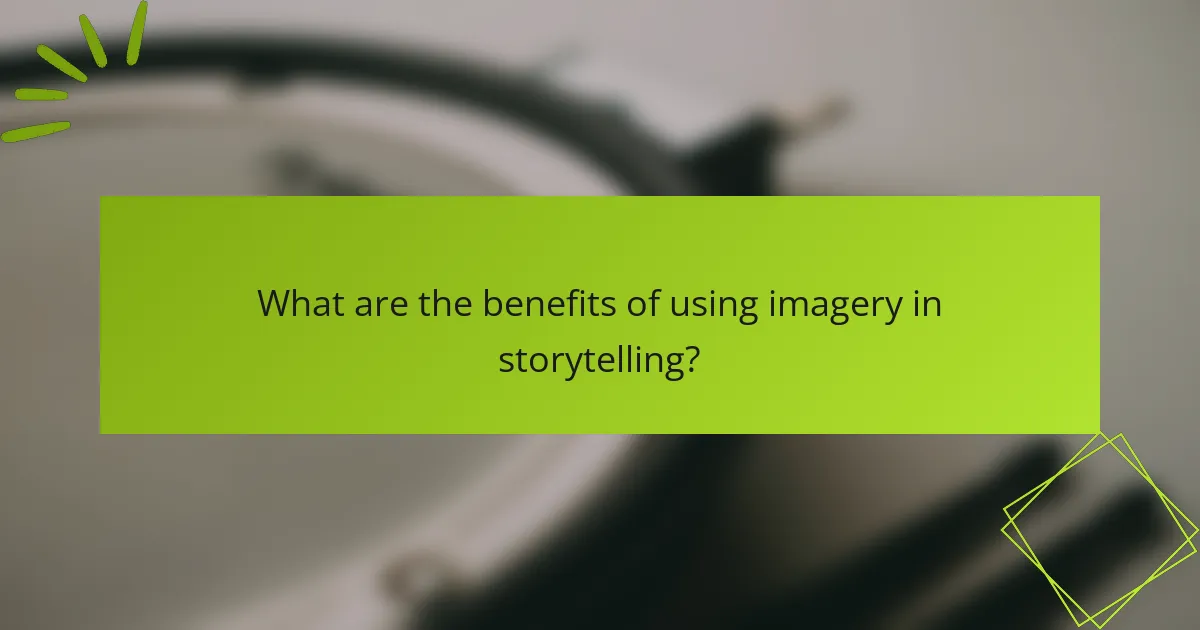
What are the benefits of using imagery in storytelling?
Using imagery in storytelling enhances the overall experience by creating vivid mental pictures that engage the audience. This technique deepens the narrative, fosters connections, and improves information retention, making stories more impactful and memorable.
Enhanced narrative depth
Imagery adds layers to storytelling by allowing readers to visualize scenes, emotions, and characters. This depth invites the audience to immerse themselves in the narrative, creating a richer experience. For example, instead of stating “the forest was dark,” describing it as “the gnarled branches twisted like skeletal fingers against the moonlit sky” evokes a stronger emotional response.
To effectively use imagery, focus on sensory details—sight, sound, smell, taste, and touch. This approach helps paint a more vivid picture, making the story resonate more deeply with the audience.
Stronger audience connection
Imagery fosters a stronger connection between the storyteller and the audience by evoking shared emotions and experiences. When readers can visualize a scene, they are more likely to empathize with the characters and their journeys. For instance, describing a character’s joy through the imagery of “a wide grin that lit up their face like the sun breaking through clouds” can create a relatable moment.
To strengthen this connection, consider the audience’s cultural context and experiences. Tailoring imagery to resonate with their backgrounds can enhance relatability and emotional engagement.
Increased retention of information
Imagery significantly boosts information retention by creating memorable associations in the audience’s mind. When stories are rich in visual elements, they are easier to recall. Research suggests that people remember visual information better than text alone, making imagery a powerful tool in storytelling.
To maximize retention, use consistent and vivid imagery throughout your narrative. Repeating key images can reinforce concepts and help the audience remember important details long after the story ends.
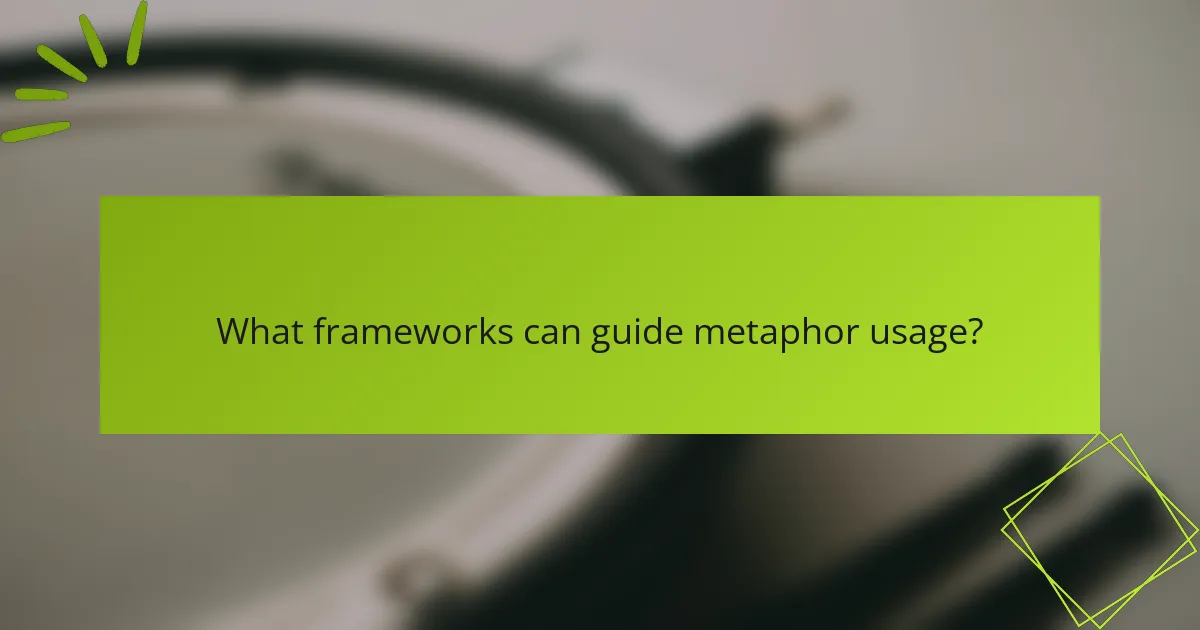
What frameworks can guide metaphor usage?
Effective metaphor usage can be guided by frameworks that help identify suitable metaphors and analyze the audience’s needs. These frameworks ensure that metaphors resonate with the intended message and connect with the audience on a deeper level.
Metaphor identification matrix
A metaphor identification matrix helps categorize and evaluate metaphors based on their relevance and effectiveness. This matrix typically includes criteria such as clarity, emotional impact, and cultural resonance. For example, a metaphor like “life is a journey” may be universally understood, while “life is a chess game” might resonate more with strategic thinkers.
When creating a metaphor identification matrix, consider using a simple table format to compare different metaphors against these criteria. This can help in selecting the most impactful metaphor for your audience.
Audience analysis criteria
Understanding your audience is crucial when selecting metaphors. Audience analysis criteria include demographics, cultural background, and familiarity with the subject matter. For instance, a metaphor that works well for a tech-savvy audience may not resonate with a general audience.
To effectively analyze your audience, gather data through surveys or focus groups. This information will guide you in choosing metaphors that align with their experiences and values, enhancing engagement and connection.
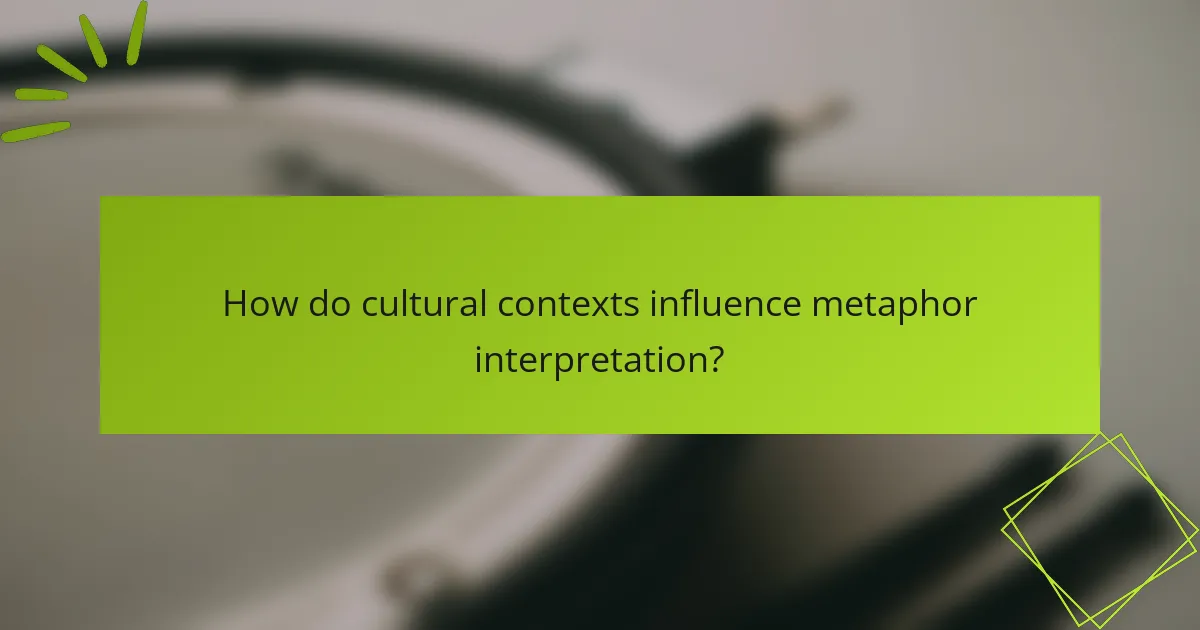
How do cultural contexts influence metaphor interpretation?
Cultural contexts significantly shape how metaphors are understood, as they draw on shared experiences and values within a community. Different cultures may interpret the same metaphor in varied ways, leading to potential misunderstandings or richer meanings depending on the audience’s background.
Regional variations in meaning
Metaphors can vary widely in meaning across different regions, influenced by local customs, language, and history. For example, the metaphor “to throw in the towel,” which signifies giving up, may resonate differently in cultures where sports like boxing are less prominent.
In some cultures, metaphors related to nature, such as “weathering the storm,” might evoke strong imagery of resilience, while in others, they could be interpreted more literally or differently based on local environmental experiences. Understanding these nuances is crucial for effective communication.
To navigate these regional variations, consider the audience’s cultural background when using metaphors. Researching local idioms and expressions can help ensure that your message is both clear and impactful, avoiding potential pitfalls of misinterpretation.
